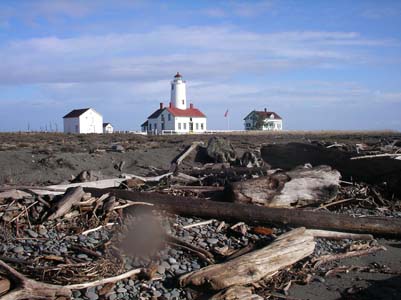Strait (Part 1)
Report from Ken
10/15/05 – 10/16/05
The Straits of Juan de Fuca form the entrance to Puget Sound, the San Juan Islands and Vancouver Island's Sunshine Coast. The water that laps on the shores of Budd Inlet, Sucia Island and Desolation Sound has passed through this waterway at one point or another, and is destined to pass this way again in the future. Shipping is almost constant, with vessels from around the world traveling through on their way to Seattle, Tacoma and Vancouver.© 2005 Azimuth Expeditions. All rights reserved
I am currently a board member of the Washington Water Trails Association, a Seattle-based organization that administers several different marine trails in different areas around the state. The Cascadia Marine Trail, centerpiece of the WWTA's various endeavors, offers paddlers an integrated network of camping and launching points throughout Puget Sound, but there are presently no trail sites along the southern shore of the Straits. Over the course of this winter I will be paddling the entire length of the Straits Washington shoreline, on the lookout for possible sites that might be able to be added to the CMT at a future date. This 2-day paddle was the first leg of the journey.
Three of us left from the beach at Fort Worden State Park in Port Townsend on the morning of October 15th. (Fort Worden is, at this time, the westernmost point on the CMT.) In addition to myself there was Michael, another member of the WWTA board, and Kari, an Azimuth guide and Matelót kayak club member. Despite ongoing rain and foul weather in Tacoma and Seattle, the day dawned sunny and warm where we were, with very little wind. We set out into a current that, although it was set against us, didn't pack much force, and we were able to make excellent progress right from the start.
The coastline to the west of the park started out low to the shore, but within a short distance became much higher. A small ribbon of beach at the base of towering dirt and stone cliffs was the characteristic sight on our left as we negotiated the rock gardens and kelp beds close to the shore. There were houses and other buildings visible from time to time, but all were well above us, giving the impression at water level that we were farther away from settled areas than we actually were.
After a rest stop at a gravel beach near Rocky Point, we made our first crossing of the day, a three-mile open water stretch toward Protection Island. Once scheduled for development, most of the island is now a National Wildlife Refuge and visitors are required to maintain a distance of 200 yards from shore. Home to a variety of nesting seabirds as well as hundreds of seals, the island lies within easy view of Highway 101 at the mouth of Discovery Bay, yet feels like it's a world away when you experience it close-up. The beach at the east end of the island was being used by a group of at least 150 seals as we approached, and the air was filled with the bellows and grunts of their casual conversation.
Although most of the island is a no landing zone, the western tip is owned by the Washington Department of Fish and Wildlife and it is permissible to come ashore. (Landing is strongly discouraged, however, between March and September because of wildlife concerns.) Since it was October, we put ashore and had our lunch in the sun near the spit at the end of the island.
Crossing back to the mainland, we saw a couple spots that might be suitable for a WWTA site. I highlighted them on my chart and we pushed on for Sequim Bay State Park, where we had planned to spend the night. Sequim Bay has a long spit at its entrance that almost completely cuts it off from the Straits, with a narrow entrance that can produce fairly strong currents during big tidal exchanges. We paddled through it, got to the beach at the park, and claimed a campsite.
The next morning we were joined by other paddlers: Marc, another Azimuth guide, and three of his friends that were coming along on the day's paddle to Cline Spit. The weather was less ideal than the day before, but wind was still light and although we could see the rain in the hills, it was not falling on us.
The shoreline was much more settled than what we had passed through previously, with large collections of beach houses and neighborhoods at various places along the route. It was also duck hunting season and at a few marshy spots along the way, we were treated to the sound of shotguns and barking dogs. We had planned on going out to the Dungeness lighthouse, but with the size of the group and the late start we'd gotten, we opted not to do so. (The lighthouse pictures that accompany this report are from other trips to the area.) Once in the lee of Dungeness Spit, the water turned to glass and each paddle stroke seemed to make the kayaks glide better, faster and with less effort.
We ended this leg of the journey at the Cline Spit boat launch, where the vehicles that we had shuttled earlier in the day were waiting. Once we got the boats and gear loaded up, we all headed in to Port Angeles to stuff ourselves with Indian food before the drive back home.
Stay tuned to the Field Reports page for an update on the second leg of the Straits voyage, scheduled for December of 2005.
azimuth expeditions
























